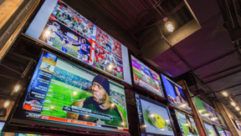HDTV: getting ready for what?
Dec 1, 1999 12:00 PM,
Peter H. Putman
It has been a few months since I visited the topic of HDTV, and dependingon your point of view, either a lot has happened, or not much at all hashappened in the interim. There has certainly been plenty of press buzzgenerated by such events as Sony’s refitting of the Tonight Show studiosfor 16:9 1080i broadcasts and Panasonic’s built-from-scratch 720p locationvideo truck now producing ABC’s Monday Night Football broadcasts.
What does any of this mean to you for your next installation project? Willany of the benefits promised by digital television – wide-screen,high-definition images plus other digital goodies such as channelmultiplexing – accrue to any of your current and potential client base?Chances are that many of your clients are looking to you for that answer.
As with any new technology, DTV must undergo several stages of developmentbefore it achieves widespread consumer acceptance. Right now, we are stillstuck in the first stage – the technology rollout in which experts debatethe pros and cons of the different DTV formats; broadcasters scramble toget any program content on-line, and such DTV products as set-top boxes andTV sets are still rather pricey items that will sit dormant for much of thetime.
The format debates are currently occupying much of the public’s interest.You may have heard that there are 18 different HDTV transmission formats.That is not true. There are only six that offer any image resolution aboveour beloved NTSC system (525 lines, 480 visible, interlaced scan). Thoseare:
– 1,920 pixels on 1,080 lines, progressively scanned at 30 Hz refresh
– 1,920 pixels on 1,080 lines, interlaced scan at 30 Hz refresh
– 1,920 pixels on 1,080 lines, progressively scanned at 24 Hz refresh
– 1,280 pixels on 720 lines, progressively scanned at 60 Hz refresh
– 1,280 pixels on 720 lines, interlaced scan at 30 Hz refresh
– 1,280 pixels on 720 lines, progressively scanned at 24 Hz refresh
Of the first group, 1,920infinity1,080 interlaced (1080i) has already beenimplemented by several stations, and it will be the format of choice forthe CBS and NBC television networks. The 1,920infinity1,080p, 30 Hz formatrequires twice the bandwidth of 1080i, and it will probably not be used asa broadcast format but only for such custom display applications as digitalcinema and other high-resolution imaging. The 1,080p, 24 Hz format willbecome a production standard for the film industry as it looks to achievecompatibility between 35 mm film and HDTV production.
Of the second group, the favorite of ABC is 720p. There have been manydiscussions about the image quality of 720p versuss 1,080i broadcasts,which revolve around the inability of most projectors and monitors to showall the detail in a 1,080i image. Such 720p format advocates as Joe Kanemake a good point that the average viewer will not be able to tell thedifference in most cases between 1,080i and 720p, and 720p is preferable inthat it uses a progressive image scan, thereby eliminating image flicker -one of the necessary evils of our present 525-line video standard.
There is even some groundswell of support for a format not originallymentioned – 560p, or 560 lines progressively scanned. Why 560p? Well, thisformat has half the resolution of a 1,080 line broadcast, and the feelingis that a 560p image will appear crisper because the 1,080 interlacedscanning system only allows viewers to see 560 lines per video field.
So, what do you do? First of all, do not lose sight of the fact that thisis an entirely digital system, meaning that the encoders and decoders canbe changed fairly easily to transmit and receive pretty much any signal youwould want. In effect, we could have hundreds if not thousands of DTV/HDTVstandards with a digital system. For proof, look no further than a DVDplayer, which can also play back audio CDs.
Right now, while you are still reading articles about HDTV and scratchingyour head, manufacturers are already bringing second-generation set-topdecoder boxes to market. They will be about half the price of the originalsand offer more decoding options. Early models basically supported 1,080i,480i (a digital version of what we have now) and 480p (progressive-scan 4:3video, not unlike a 640infinity480 computer display).
These newer set-top boxes are adding an option for 720p. On some oldermodels, this signal was up-converted to 1,080i before viewing, which kindof defeats the purpose of having a progressive-scan image. Now, 720psignals can be directly decoded and fed to the appropriate display.Panasonic already has such a decoder available for sale (the TU-DST50), andothers will soon follow.
Eventually, set-top boxes will be smart enough to recognize any HDTV andDTV signal format, automatically decoding it into a component video signalready for display. You will not need to fret as much about the actualnumbers as you will the image aspect ratio. Any HD-format signal implies awide (16:9) image, whereas standard definition (SD) television willcontinue in the familiar 4:3 format we know and love. Currently, you havegot options here, and I am sorry that I cannot tell you which way to go.
The first option involves using existing 4:3 display technologies likerear-projection monitors, direct-view TV sets, and flat-matrix LCD/DLPprojectors to show letterboxed 16:9 images with a dark area above and belowthe image. This may be the most practical approach; most of your client’sdisplay needs will probably continue to be in the 4:3 format for the nearterm, and letterboxing is a small inconvenience to pay.
The second solution means starting to make the move to wide-screendisplays, including 42 inch (1,067 mm) and 50 inch (1,270 mm) plasmamonitors, 16:9 direct-view TV sets, and the odd LCD projector with 16:9panels like Sony’s new VPL-VH10WT. If you have a CRT front projector, youcould simply change to a 16:9 projection screen. Of course, any 4:3 imagesyou show will now have dark areas on the left and right side of the imageunless you install a motorized screen with custom side panels and masks.
Custom masked screens are now available that will change aspect ratios from16:9 to 4:3 and back again. Da-Lite’s Horizon Electrol model is designedfor ceiling flush mounting and simultaneously raises the screen whilelowering a top blackout drape to go from 4:3 to 16:9, all while maintaininga constant optical center. It weighs a few pounds, but it does solve theaspect ratio problem quite nicely.
The last question is signal compatibility. When it comes to outputconnections on set-top boxes, let the buyer beware. Standards vary frommanufacturer to manufacturer; Sharp’s DTV-1000 set-top box was attractivefrom a systems integrator’s point of view because it supports bothtri-level sync output (Y, Cb, and Cr component video signals) and RGBSconnections. On the other hand, Panasonic’s TU-DST50 can give you only480i/p, 720p and 1,080i as a YCbCr signal. Although the DTV-1000 comes withBNC, RCA and even 15-pin d-sub jacks, the TU-DST50 gives you three RCAjacks, and that is all.
You will find that more and more HD-ready equipment, including W-VHS,D-VHS, and future HD-DVD players, will only support the tri-level syncformats. That is just a reflection of the consumer bias in manufacturing soprevalent in Japan these days, one that is carried to extremes in NECTechnologies’ Plasma-Sync 5000W and 4210W plasma monitors – the video inputconnections use RCA and DIN jacks.
If that thought scares you, one handy gadget to have around any futureHDTV-ready installations would be Extron Electronics’ CVC 200 video formatconverter. This box takes a variety of component video signals and convertsthem from esoteric formats like YUV and YCbCr to something your existingdisplays are more used to seeing – sync on green (RGsB), composite sync(RGBS) and component sync (RGBHV). Other companies like Inline and Altinexwill also offer such converters to the installation market.
Do not lose sight of this fact: There remains little HDTV programmingavailable for viewing right now. Even after the turn of the year, whenseveral hundred stations will be broadcasting some form of HDTV – or evenjust DTV – there will not be a lot of original shows to view on-air letalone from digital discs or tape sources. Unless you are installing abroadcast facility, you will not need to obsess about HDTV-compatibilityjust yet.
You should, however, make sure that the cable infrastructure and interfacesin any new installation are capable of passing the necessary bandwidth forHDTV signals (figure at least 200 MHz to start) and that you have at leastfour-wire RGBS signal distribution when you will need it. Many newerprojectors and monitors have built-in tri-level sync capability, but notall; check the specs to make sure so that you do not have to talk yourclient into an upgrade a couple of years from now.
For front and rear-projection installations, try to choose a combination offocal length, screen size and projection throw distance that will let youdo a reasonable screen or lens upgrade in the future when you will want16:9 imaging. It would not hurt to specify a flat-matrix projector with atleast 1,280infinity1,024 resolution if you think your client’s demand forHDTV playback isn’t far off. You will have at least 1:1 compatibility with720p signals.








